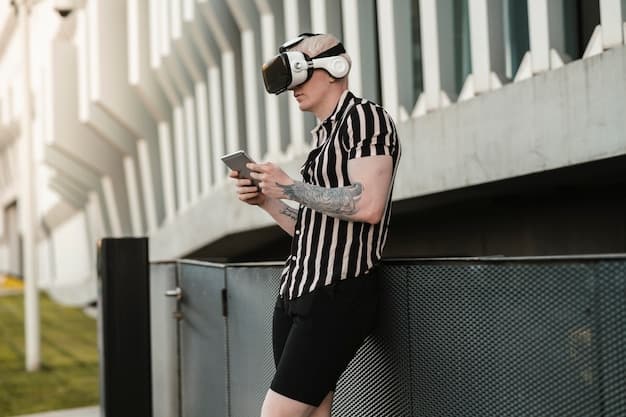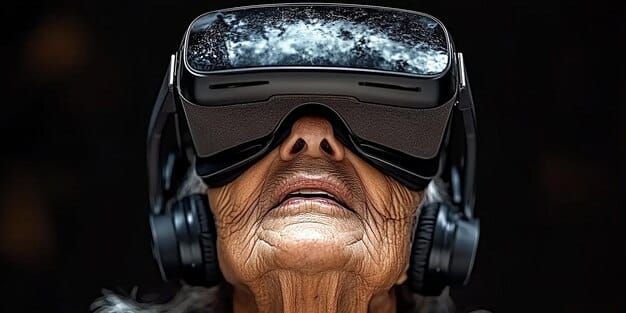5G and Mobile VR: Unleashing Low Latency Gaming on the Go

The Impact of 5G on Mobile VR is revolutionizing gaming, offering enhanced low latency experiences for immersive on-the-go gameplay.
The evolution of mobile virtual reality (VR) is taking a giant leap forward, thanks to the advent of 5G technology. This next-generation network is poised to overcome some of the biggest hurdles that have held back mobile VR, especially in the realm of gaming. Experience the revolution of 5G on Mobile VR: Low Latency Gaming on the Go.
The Dawn of 5G-Enabled Mobile VR
The integration of 5G technology with mobile VR is setting the stage for unprecedented gaming experiences. With its ultra-fast speeds and extremely low latency, 5G has the potential to unlock a new era of immersive, high-fidelity mobile VR gaming that was previously unimaginable.
Imagine playing a graphically intensive VR game on your mobile device with virtually no lag or delay. This is the promise of 5G, and it’s rapidly becoming a reality.
Enhanced Speed and Bandwidth
One of the most significant advantages of 5G is its ability to deliver much higher data transfer rates compared to 4G. This increased bandwidth means that VR headsets can stream high-resolution textures, complex 3D models, and intricate game environments seamlessly, leading to sharper visuals and more detailed virtual worlds.
- Faster download and upload speeds result in quicker game loading times.
- Improved streaming quality ensures smoother VR experiences.
- Higher bandwidth capacity allows for more complex and dynamic game environments.
Lower Latency for Real-Time Interaction
Latency, the delay between an action and its corresponding reaction in the VR world, has always been a critical issue for mobile VR gaming. High latency can cause motion sickness, immersion breaking lag. 5G significantly reduces latency, making real-time interactions more responsive and natural.
- Reduced latency minimizes motion sickness by providing more accurate tracking and responsiveness.
- Real-time multiplayer gaming becomes seamless with near-instantaneous data transmission.
- Precise and accurate control inputs enhance the overall gaming experience.

In conclusion, 5G’s enhanced speed and reduced latency are revolutionizing mobile VR gaming, ushering in a new era of immersive and responsive experiences. Gamers can anticipate lifelike visuals, seamless multiplayer interactions, and overall gaming experiences that redefine what is possible on mobile VR devices.
Overcoming Technical Challenges in Mobile VR
Mobile VR has traditionally faced several technical hurdles that have limited its potential. These limitations include processing power, battery life, and connectivity. 5G technology is stepping in to squarely address these challenges, paving the way for more capable and immersive mobile VR experiences.
With the potential of 5G advancements, more seamless and engaging encounters within the VR world become achievable.
Processing Power Constraints
Mobile devices have limited processing power compared to high-end PCs or consoles. This constraint has meant that mobile VR games often have lower graphical fidelity and less complex gameplay mechanics. 5G can offload some of the processing burden to the cloud, enabling mobile devices to run more demanding VR applications.
- Cloud rendering allows resource-intensive tasks to be performed remotely.
- Mobile devices can focus on displaying the rendered content, reducing strain on their processors.
- Higher-fidelity graphics and more complex game mechanics become feasible on mobile VR.
Battery Life Limitations
Running VR applications can be power-intensive, quickly draining the batteries of mobile devices. By offloading some processing tasks to the cloud and optimizing data transmission, 5G can help extend battery life during VR gaming sessions.
- Reduced processing load on mobile devices leads to lower power consumption.
- Efficient data transmission minimizes wasted energy.
- Extended battery life allows for longer and more immersive VR gaming sessions.

Connectivity Issues
Prior to 5G, mobile VR often suffered from inconsistent connectivity, leading to lag, disconnections, and a subpar gaming experience. 5G provides a more reliable and stable connection, ensuring a smoother and more immersive VR experience.
- Stable and consistent connections minimize interruptions and lag.
- Seamless data transmission allows for uninterrupted gameplay.
- Improved connectivity enhances the overall VR gaming experience.
In summary, 5G is revolutionizing the realm of mobile VR by tackling persistent technological obstacles. Through cloud rendering, efficient power utilization, and enhanced stability in connectivity, 5G is effectively minimizing the limitations, propelling mobile VR toward previously unattained echelons of performance and immersion.
Implications for Gaming on the Go
5G’s capabilities will significantly transform mobile VR gaming, letting users enjoy high-quality VR experiences while on the move. Whether commuting, traveling, or simply relaxing outdoors, mobile VR gaming supported by 5G will offer unprecedented freedom and flexibility.
This will expand VR gaming beyond the confines of the living room, unlocking new possibilities for entertainment and engagement.
Portable VR Arcades
With 5G, any location becomes a potential VR arcade. Users can set up a mobile VR gaming station in a park, at a coffee shop, or on a train. Imagine playing a multiplayer VR game with friends in real-time, regardless of your physical location.
- Mobile VR arcades can be set up anywhere with 5G coverage.
- Multiplayer VR gaming becomes a social and location-agnostic experience.
- New forms of entertainment and social interaction emerge through mobile VR.
Location-Based VR Experiences
5G-enabled mobile VR can also facilitate location-based VR experiences. Games can be designed in such a way so they use your real-world location. This feature would superimpose virtual elements onto the real world, enabling innovative and immersive gameplay.
- Educational games use location data to deliver relevant information about landmarks.
- Promotional games reward players for visiting specific locations.
Challenges and Considerations
Despite the potential, the widespread adoption of 5G-enabled mobile VR gaming may face some challenges. The availability of 5G coverage is not yet ubiquitous, and data plans can be expensive. Overcoming these obstacles will be important for realizing the full potential of mobile VR gaming on the go.
- Expanding 5G infrastructure to ensure wider coverage.
- Making 5G data plans more affordable and accessible.
- Addressing concerns about data privacy and security in location-based VR experiences.
As coverage becomes more widespread and economical, 5G’s low-latency capabilities will bring notable innovations to gaming on the go, allowing gamers to engage in robust and immersive experiences across diverse locations.
Key Players and Ecosystem Development
The success of 5G-enabled mobile VR gaming hinges on the collaborative efforts of various players in the ecosystem, including mobile network operators, VR headset manufacturers, game developers, and content providers. Together, these stakeholders must work together to create a seamless and compelling user experience.
Their combined work is critical in setting new benchmarks for the advancement and broad implementation of virtual reality (VR) functionalities on mobile platforms.
Mobile Network Operators
Mobile network operators play a critical role in providing the necessary infrastructure and connectivity to support 5G-enabled mobile VR gaming. They need to invest in expanding 5G coverage, optimizing network performance, and offering data plans that meet the demands of VR applications.
- Expanding 5G coverage to reach more areas and users.
- Optimizing network performance to minimize latency and maximize bandwidth.
- Offering affordable and flexible data plans that cater to the needs of VR gamers.
VR Headset Manufacturers
VR headset manufacturers are responsible for creating innovative and high-quality VR headsets that are compatible with 5G technology. These headsets must be lightweight, comfortable, and equipped with high-resolution displays and precise tracking capabilities.
- Reducing the weight and size of VR headsets for enhanced portability.
- Improving display resolution and refresh rates for sharper visuals.
- Integrating advanced tracking technologies for more accurate and responsive interactions.
Game Developers and Content Providers
Game developers and content providers are essential for creating compelling and immersive VR experiences that take full advantage of 5G capabilities. This requires designing games and applications that are optimized for low latency, high bandwidth, and mobile devices.
- Developing VR games with high-fidelity graphics and complex gameplay mechanics.
- Optimizing VR experiences for low latency and seamless streaming.
- Creating location-based VR experiences that utilize 5G connectivity.
The convergence of these roles is vital for guaranteeing that virtual reality meets its potential on mobile platforms, offering users an enriching and immersive digital experience.
The Future of Mobile VR Gaming with 5G
The future of mobile VR gaming with 5G looks incredibly promising. As 5G technology continues to mature and proliferate, we can expect even more immersive, realistic, and engaging VR experiences on mobile devices. VR gaming will undergo a massive technological shift because of 5G’s expansion over the next few years.
This evolution is setting the stage for innovations in virtual reality, with mobile platforms at the forefront.
Enhanced Realism and Immersion
With continued advancements in 5G technology, mobile VR games will become increasingly realistic and immersive. High-resolution displays, advanced haptic feedback, and spatial audio will create a sensory-rich experience that blurs the line between the virtual and real worlds.
- Haptic feedback will simulate the feeling of touching virtual objects.
- Spatial audio will create a 3D soundscape that enhances immersion.
- AI-powered graphics will generate lifelike visuals and dynamic environments.
New Forms of Social Interaction
5G-enabled mobile VR will also unlock new forms of social interaction and collaboration. Imagine attending a virtual concert with friends, collaborating on a design project in a virtual workspace, or exploring a virtual museum together, all from the comfort of your own home or on the go.
- Virtual social spaces will foster connections between users from around the world.
- Collaborative VR applications will enable remote teams to work together more effectively.
- Educational VR experiences will provide interactive and engaging learning opportunities.
Transformative Applications Beyond Gaming
Beyond gaming, 5G-enabled mobile VR has the potential to transform a wide range of industries and applications. From healthcare and education to remote collaboration and tourism, VR technology can enhance productivity, improve learning outcomes, and create more engaging and immersive experiences.
- Medical professionals use VR to practice surgical procedures and train new doctors.
- Educators use VR to create immersive learning experiences for students.
- Engineers use VR to design and test new products and structures.
User Experience and Accessibility
Improving the user experience and ensuring accessibility are essential for the widespread adoption of 5G-enabled mobile VR. Effort needs to be directed to ensure that VR technology is uncomplicated, user-friendly, and accessible to individuals of varying technical backgrounds and skills.
Prioritizing user-centric design and inclusive features is paramount for reaching a broader audience and maximizing the societal impact of 5G-enabled mobile VR.
Intuitive Interfaces and Controls
VR interfaces and controls must be intuitive and easy to learn. Complex or clunky user interfaces can deter new users and hinder the overall VR experience. Simplifying interactions and providing clear guidance can ensure that users can easily navigate and interact with VR environments.
- Gesture-based controls for natural and intuitive interactions.
- Voice commands for hands-free navigation and control.
- Contextual help and tutorials to guide new users through VR experiences.
| Key Point | Brief Description |
|---|---|
| 🚀 5G Impact | Revolutionizing mobile VR with low latency and high speeds. |
| 🎮 Low Latency Gaming | Enables real-time, immersive gaming experiences on the go. |
| 🌐 Ecosystem Synergy | Requires collaboration between operators, manufacturers, and developers. |
| 📱 Use Cases | Expands beyond gaming to healthcare, education and more. |
FAQ Section
5G significantly reduces latency and increases bandwidth, enabling smoother, higher-resolution VR experiences on mobile devices. With low latency and improved responsiveness, gaming can become more immersive.
Challenges include limited 5G coverage, high data costs, and the need for optimized VR headsets and content. Widespread adoption depends on overcoming these infrastructure and economic issues.
Yes, 5G mobile VR has applications in education, healthcare, remote collaboration, and tourism. Its immersive capabilities improve learning, medical training, and remote interactions.
Cloud rendering offloads processing-intensive tasks from the mobile device to the cloud, allowing for higher-fidelity graphics and more complex game mechanics without draining battery life.
Mobile network operators provide the infrastructure, connectivity, and data plans necessary for 5G-enabled mobile VR. They ensure reliable network performance and widespread coverage for seamless VR experiences.
Conclusion
In conclusion, the transformative potential of 5G on Mobile VR: Low Latency Gaming on the Go is immense. While there remain challenges to overcome, the future looks bright, with exciting developments on the horizon that promise to reshape the way we experience virtual reality. By focusing on innovation, collaboration, and accessibility, we can unlock the full potential of 5G-enabled mobile VR and create truly immersive and transformative experiences for users around the world.





